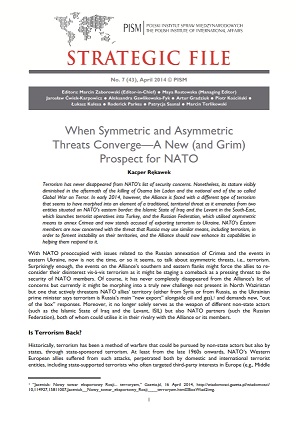№43: When Symmetric and Asymmetric Threats Converge—A New (and Grim) Prospect for NATO
№43: When Symmetric and Asymmetric Threats Converge—A New (and Grim) Prospect for NATO
Author(s): Kacper Rękawek
Subject(s): International relations/trade, Security and defense, Studies in violence and power, Radical sociology , Geopolitics
Published by: PISM Polski Instytut Spraw Międzynarodowych
Keywords: NATO; terrorism; security issues; ISIS; extreme violence; radicalism;
Summary/Abstract: Terrorism has never disappeared from NATO’s list of security concerns. Nonetheless, its stature visibly diminished in the aftermath of the killing of Osama bin Laden and the notional end of the so called Global War on Terror. In early 2014, however, the Alliance is faced with a different type of terrorism that seems to have morphed into an element of a traditional, territorial threat as it emanates from two entities situated on NATO’s eastern border: the Islamic State of Iraq and the Levant in the South-East, which launches terrorist operatives into Turkey, and the Russian Federation, which utilised asymmetric means to annex Crimea and now stands accused of exporting terrorism to Ukraine. NATO’s Eastern members are now concerned with the threat that Russia may use similar means, including terrorism, in order to foment instability on their territories, and the Alliance should now enhance its capabilities in helping them respond to it.
Series: PISM Strategic File
- Page Count: 5
- Publication Year: 2014
- Language: English
- Content File-PDF

